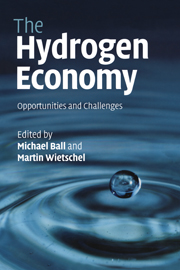Book contents
- Frontmatter
- Contents
- List of main contributors
- Preface
- Acknowledgements
- List of abbreviations
- 1 Scope of the book
- 2 Why hydrogen?
- 3 Non-renewable energy resources: fossil fuels – supply and future availability
- 4 Non-renewable energy resources: nuclear fuels
- 5 Assessment of the potentials for renewable energy sources
- 6 Carbon capture and storage
- 7 Energy-chain analysis of hydrogen and its competing alternative fuels for transport
- 8 Hydrogen today
- 9 Fundamental properties of hydrogen
- 10 Hydrogen production
- 11 Hydrogen storage
- 12 Hydrogen distribution
- 13 Key role of fuel cells
- 14 Hydrogen-infrastructure build-up in Europe
- 15 Building a hydrogen infrastructure in the USA
- 16 Hydrogen and the electricity sector
- 17 Hydrogen corridors
- 18 Macroeconomic impacts of hydrogen
- 19 Sustainable transport visions: the role of hydrogen and fuel-cell vehicle technologies
- 20 Energy-efficient solutions needed – paving the way for hydrogen
- 21 The future of hydrogen – opportunities and challenges
- Further reading
- Index
- References
16 - Hydrogen and the electricity sector
Published online by Cambridge University Press: 22 January 2010
- Frontmatter
- Contents
- List of main contributors
- Preface
- Acknowledgements
- List of abbreviations
- 1 Scope of the book
- 2 Why hydrogen?
- 3 Non-renewable energy resources: fossil fuels – supply and future availability
- 4 Non-renewable energy resources: nuclear fuels
- 5 Assessment of the potentials for renewable energy sources
- 6 Carbon capture and storage
- 7 Energy-chain analysis of hydrogen and its competing alternative fuels for transport
- 8 Hydrogen today
- 9 Fundamental properties of hydrogen
- 10 Hydrogen production
- 11 Hydrogen storage
- 12 Hydrogen distribution
- 13 Key role of fuel cells
- 14 Hydrogen-infrastructure build-up in Europe
- 15 Building a hydrogen infrastructure in the USA
- 16 Hydrogen and the electricity sector
- 17 Hydrogen corridors
- 18 Macroeconomic impacts of hydrogen
- 19 Sustainable transport visions: the role of hydrogen and fuel-cell vehicle technologies
- 20 Energy-efficient solutions needed – paving the way for hydrogen
- 21 The future of hydrogen – opportunities and challenges
- Further reading
- Index
- References
Summary
If hydrogen production at a large scale is to be integrated into the energy system, a more holistic view needs to be applied, in particular, with respect to its interactions with the electricity sector. These concern, for instance, the ensuing competition for renewable energies as, in the long term, only hydrogen production using renewable energy sources offers the possibility of reducing dependence on fossil fuels and enhancing security of supply. Other examples are the dispatch of electrolysers or the possible co-production of electricity and hydrogen in IGCC plants (with CCS), which is an important aspect because such a plant design offers the opportunity of producing for two different markets, depending on the market prices for the products. Hydrogen can also be used as a storage medium for electricity from intermittent renewable energies, such as wind energy. The various aspects of the interplay between hydrogen production and electricity generation are addressed in this chapter.
Hydrogen from intermittent renewable-energy sources
Fluctuating renewable energies and hydrogen
The markets for wind power and also for photovoltaic or solar thermal power are rapidly growing (for details on renewable energies and their market development, see Chapter 5). Despite clear advantages (renewable, CO2-lean or free), the inherent characteristics of wind- and solar-generated electricity lead to several challenges. These resources are intermittent, differ in their seasonal availability and secure capacity is low, which makes it more difficult to predict power output than for conventional power plants. One additional barrier for these resources is that they depend on local conditions, like wind and place, and, therefore, the transport of electricity over long distances to demand centres could be necessary.
- Type
- Chapter
- Information
- The Hydrogen EconomyOpportunities and Challenges, pp. 482 - 506Publisher: Cambridge University PressPrint publication year: 2009
References
- 1
- Cited by



